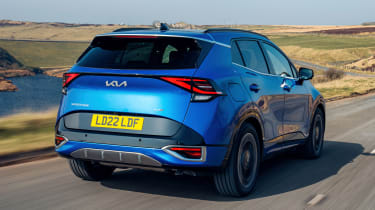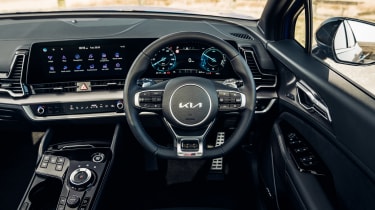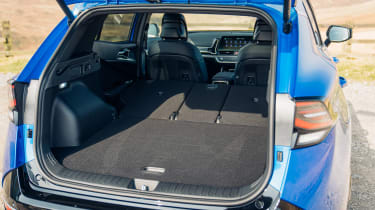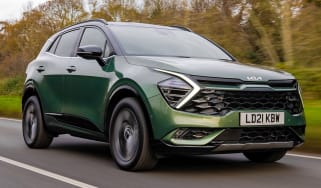Kia Sportage PHEV review
The first-ever plug-in hybrid Kia Sportage is a refined and practical family SUV, with an impressive 43-mile electric range, but it starts at just under £40,000

Pros
- Cabin quality
- 43-mile electric range
- Dual-screen infotainment
Cons
- Slightly firm ride
- Reduced boot space
- £40,000 starting price
| Car type | Electric range | Fuel economy | CO2 emissions |
|---|---|---|---|
| Plug-in hybrid | 43 miles | 252mpg | 25g/km |
Over the past three decades, the Kia Sportage has cemented a reputation as one of Britain’s best family SUVs. In 2021 it was the country’s third most popular SUV, with buyers appreciating its terrific blend of practicality, equipment and value for money, plus Kia’s famed seven-year warranty.
This latest, fifth-generation Kia Sportage builds on the success of its predecessors and retains its position near the top of the SUV tree. It’s easy to understand why, as the full-hybrid version is a hugely impressive family SUV and a worthy rival for models like the Hyundai Tucson and Volkswagen Tiguan.
But this is the plug-in hybrid Sportage PHEV, which won Best Plug-In Hybrid Family Car in the 2023 DrivingElectric Awards. It combines the regular Sportage's show-stopping looks, tech-filled cabin and generous boot space with impressive pure-electric driving range and fuel economy. As well as being an ideal family car, company-car drivers and anyone looking to reduce their fuel consumption should be considering this model, too.
The Sportage PHEV shares its powertrain with the Hyundai Tucson Plug-In. Under the bonnet is a 1.6-litre turbocharged petrol engine coupled to a single electric motor fed by a 13.8kWh battery. The result is a combined 261bhp and 350Nm of torque – enough to take the nearly-two-tonne SUV from 0-62mph in 7.9 seconds. A six-speed automatic is the only gearbox for the PHEV and all-wheel drive is standard.
More importantly, Kia claims the plug-in Sportage will cover 43 miles on electric power alone – upped to 48 miles if you’re just driving around town. That’s further than its Tucson Plug-In cousin can boast and should be plenty for completing the school run or daily commute without using a drop of petrol. The Sportage PHEV also returned up to 252mpg fuel economy in official testing, while CO2 emissions stand at 25g/km. Fully recharging the 13.8kWh battery from a home wallbox will take just under two hours.
The other benefit for being so efficient is the plug-in Sportage gets an enticing 8% Benefit-in-Kind (BiK) tax rating – around a third the rate the full-hybrid version attracts. If you’re a company-car driver sizing up the advantages of the two electrified Sportages, note that a 20% taxpayer could save up to £5,000 a year in tax alone by going for the plug-in variant.
But there is a catch. At more than £40,000 for the entry-level GT-Line, the PHEV is nearly £5,000 more expensive than the equivalent Sportage Hybrid. It also nudges the Sportage into the premium rate of VED (road tax), meaning the PHEV will cost £560 a year to tax from year two. While that’s a £10 discount on the standard rate, it’s also significantly more than the £160 it costs to tax a Sportage Hybrid.
The range starts with the GT-Line, which is essentially a mid-spec trim level. Highlights include 19-inch alloy wheels, 12.3-inch touchscreen infotainment system, quilt leather suede seats, rear privacy glass, keyless entry and go, smart cruise control, front and rear electric windows, forward collision avoidance assist and lane follow assist.
Moving up to the Sportage 3 trim adds different 19-inch alloys, a second 12.3-inch display in place of the instrument cluster, heated front and rear seats and a heated steering wheel.
The flagship GT-Line S pushes the Sportage deep into premium territory. Highlights include an impressive Harman Kardon audio system, suede upholstery, driver memory seat, ventilated seats, electric tailgate, blind spot collision avoidance assist, blind spot view monitor and surround view monitor. A two-tone roof is optional.
There are several driving modes to choose from including EV, Hybrid and a third labelled Automatic, which decides how best to blend the petrol and electric power. The Sportage PHEV also has Eco and Sport modes, and settings for different terrain.
Eco is what you roll away in, silently on the electric motor. Our car indicated 37 miles of electric range on a fully charged battery, and overall the plug-in hybrid setup feels natural in the Sportage. It’s worth noting, though, that the addition of the hybrid system does add 330kg over the petrol Sportage.
The plug-in Sportage is a decent cruiser. Wind noise is well suppressed, plus the hybrid system is refined and manages switching between the different power sources well. On the motorway, it’s a serene place to be, thanks to the ability to run on electric power alone at higher speeds.
Because you never feel rushed behind the wheel of the Sportage PHEV, its Sport mode feels unnecessary, and doesn’t do a lot to improve performance or add a sense of excitement to proceedings. The steering isn’t particularly sharp, either. But let the Sportage PHEV do its thing and you’ll be rewarded with effortless fuel economy; we managed to return 87mpg on our car’s trip computer without fuss.
The Sportage’s ride, however, lets the car down. It’s not firm enough to be off-putting by any means, but it doesn’t deal with bad surfaces particularly well, although the 19-inch wheels probably don’t help in this regard; it’s a shame the PHEV isn’t available with the standard Sportage’s smaller 18-inch alloys.
But what is impressive about the Sportage is the generous amount of kit and technology on board. In all versions bar the base model, you’re presented with two 12.3-inch displays for the infotainment and driver information. Meanwhile, the centre panel controls in the dashboard can flick between either heating and ventilation or infotainment controls, as in the pure-electric Kia EV6. Kia has also been liberal with the application of soft-touch plastics in the Sportage, and overall it’s a pleasant place to sit.
Safety is a strong point, with the Sportage gaining a five-star Euro NCAP crash-test rating in mid-2022. Adult and child occupant protection were rated at 87% and 86% respectively, while the safety assistance score was 72%. The rating applies across all the trim levels and powertrains that make up the Sportage range.
Space inside is strong, too, with passengers in the rear only missing out on a little foot room as a result of the hybrid system. Boot space does take a hit in the plug-in hybrid compared to others in the line-up, but 540 litres is perfectly acceptable. Plus, you can lower the rear seats and expand the space on offer to 1,715 litres.
While the notion of a £40,000-plus Kia isn’t so unimaginable after the arrival of the EV6, private buyers may still struggle to reconcile the price increase over the already impressive full-hybrid. However, the Sportage PHEV can comfortably wear that price tag, as it combines all the best qualities from Kia’s latest offerings, including efficient hybrid technology and excellent cabin quality.








